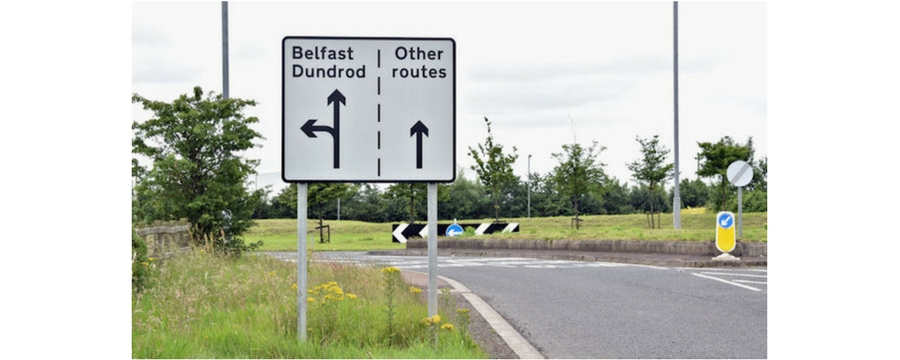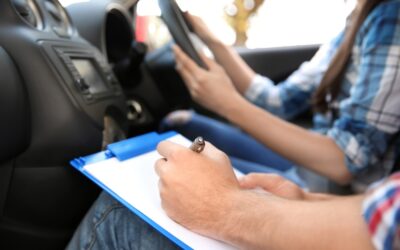Roundabouts are designed to aid the flow of traffic where there are more than two roads a driver can take at one junction. For the learner driver, approaching roundabouts for the first time can be a daunting prospect. There will appear to be a lot going on within a relatively small area. Various vehicles travelling together in parallel lanes, some going left, some going right – bigger roundabouts can look quite confusing!
It is certainly true that your observation skills need to be good and you will be making decisions and taking actions much faster than on a normal straight road. But the rules and codes for dealing with the situation ensure that all drivers are aware of other road users and that each are clearly showing where they are intending to go. So even though it appears quite muddled at first sight – in reality, if everyone plays their part, it is all very orchestrated and safe and makes junctions much easier.
And don’t worry, your instructor will start you off on simple, quiet roundabouts for your initial experiences. You will need to get used to the fundamental process but first of all let’s look at the roundabout itself.
Fundamentals and types of roundabout
The first notice you will have that you are approaching a roundabout is likely to be a traffic sign. Depending on the size of the roundabout this could be the red triangle with the black chasing arrows; a circular blue sign with white chasing arrows or a large white sign which clearly highlights where the junctions are on the roundabout and the geographical location associated with each one.

Large roundabouts
On larger roundabouts, you may see “reduce speed now” signs and yellow painted lines on the road to help highlight the need to curtail speed on approach. Larger roundabouts may also use traffic lights to aid the flow of the traffic.
Small or mini-roundabouts
The smallest roundabouts are called mini-roundabouts and are seen as painted circles in the middle of a number of junctions. As small as they are, they should be treated with the same respect as any other roundabout.
Your instructor will also tell you about open and closed roundabouts.
- A closed roundabout is one where you cannot clearly see what traffic is approaching from the right until you have pulled up at the junction.
- An open roundabout gives you a clearer vision so you may be able to enter the roundabout without stopping if it is clear and safe to do so.
The driving code on approaching roundabouts
The mirror, signal, position speed and look (MSPSL) procedure will be fundamental to the process. As with mirror, signal, manoeuvre, by using internal mirror, wing mirrors, indicator and positioning you will be showing to others where you intend to go and moving only when it is safe to do so. Before changing lanes (often there is more than one lane on approach and more than one lane on the roundabout) always check to make sure it is safe to do so.
Where you position your car will give other road users an idea of your intentions. For instance, (where there is only one lane), if you wish to go right, your vehicle should be positioned as near to the middle white line as possible and you should be indicating to go right. If you wish to go left it will be close to the pavement with your left indicator on and if you wish to go straight on your car will be central to the road with no indicator. Some roundabouts will have more than one lane on approach (i.e. if you are taking the right junction you will need the right lane). Look out for any signs that might give you more information about which lane you need to be in.

On approach, determine whether the roundabout is closed or open and slow down to an appropriate speed by covering the brake and the clutch. At around 10 to 15 meters from the junction line, ensure you are driving at around 10 mph and select 2nd gear. If you need to stop you may need to go down into first gear and stop the car before the roundabout junction line.
Circumnavigating the roundabout
In the UK, you must give way to traffic on your right and traffic already on the roundabout. This is where your looking and observation skills really will come into play. Many learners make the mistake of just looking to the right hoping to spy their chance as to when they can move forward safely onto the roundabout. It is important you also look in the direction you are going so you can judge your speed as you join the flow of traffic. You will find 2nd gear is right for traversing the roundabout.
Exiting the roundabout
The following procedures are for larger roundabouts with more than one lane. Many of these are designed so you are filtered into the correct lane for exit – but not all do.
Turning left
If you are turning left you will either be in the left lane or on the left side of the road. As you approach the roundabout you know you will be taking the first junction, so you should indicate – just as if you were taking a left turn. You will slow down as you approach. If it is an open roundabout you should change down to 2nd gear and be ready to turn left if there is no traffic advancing from the right. Be prepared to stop if there is heavy traffic or if it is a closed roundabout. Move onto the roundabout and take the first junction when safe to do so.
Going straight on
If you are going straight on when approaching roundabouts, you should take the middle lane or keep central to the road. You will only indicate when you wish to show to other road users that you are about to exit the roundabout. Again, slow down to second gear and ensure that your vision is clear. Move off when it is safe to do so and as you circumnavigate the island keep in the middle lane until you are passing the lane immediately before the junction you want. It is at this point you should check your mirror, signal your intention to move to the left lane (so you can easily take your junction) and when safe to do so move into the left lane. You have now positioned your car and are showing to other road users where you intend to go. You can now take the junction leading straight on and you will leave the roundabout.
Turning right
If you are turning right at the roundabout, you should take the right-hand lane or keep right on the road. As you are navigating the whole of the roundabout you should indicate right on approach. Again, slow down to second gear and ensure that your vision is clear. Move off when it is safe to do so and as you circumnavigate the roundabout keep in the right lane until you are about a third of the way round. It is at this point you want to move into the middle lane so you can make your exit in stages as you move with the flow of traffic. So you will need to check your mirrors, indicate left and change lanes.
As you are passing the lane immediately before the junction you will need to move to the left lane. So, you will repeat the above process again. It is at this point you should check your mirror, signal your intention to move to the left lane (so you can easily take your junction) and when safe to do so move into the left lane. You have now positioned your car and are showing to other road users where you intend to go. You can now take the junction leading right and you will leave the roundabout.
Once you are safely dealing with roundabouts you are really on your way to passing your driving test. Don’t leave checking out getting the best car insurance until the last minute. Why not get a quote today?
Image credits:
1. (red triangle roundabout sign) No attribution required
2. (blue circle roundabout sign) No attribution required
3. (green roundabout sign) RedRag, Geograph under this Creative Commons Licence
4. (roundabout lane sign) Albert Bridge, Geograph under this Creative Commons Licence



